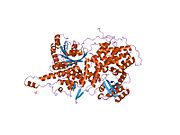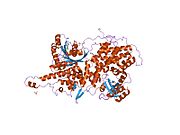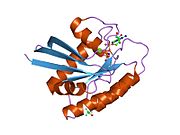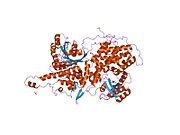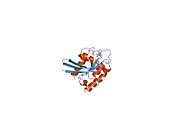HRAS
Ensembl | |||||||||
|---|---|---|---|---|---|---|---|---|---|
| UniProt | |||||||||
| RefSeq (mRNA) | |||||||||
| RefSeq (protein) | |||||||||
| Location (UCSC) | Chr 11: 0.53 – 0.54 Mb | Chr 7: 140.77 – 140.77 Mb | |||||||
| PubMed search | [3] | [4] | |||||||
| View/Edit Human | View/Edit Mouse |
GTPase HRas, from "Harvey Rat sarcoma virus", also known as transforming protein p21 is an
Function
GTPase HRas is involved in regulating cell division in response to
. These proteins all are regulated in the same manner and appear to differ largely in their sites of action within the cell.Clinical significance
Costello syndrome
At least five inherited mutations in the HRAS gene have been identified in people with Costello syndrome. Each of these mutations changes an amino acid in a critical region of the HRAS protein. The most common mutation replaces the amino acid glycine with the amino acid serine at position 12 (written as Gly12Ser or G12S). The mutations responsible for Costello syndrome lead to the production of an HRAS protein that is permanently active. Instead of triggering cell growth in response to particular signals from outside the cell, the overactive protein directs cells to grow and divide constantly. This uncontrolled cell division can result in the formation of noncancerous and cancerous tumors. Researchers are uncertain how mutations in the HRAS gene cause the other features of Costello syndrome (such as mental retardation, distinctive facial features, and heart problems), but many of the signs and symptoms probably result from cell overgrowth and abnormal cell
Bladder cancer
HRAS has been shown to be a
Other cancers
Somatic mutations in the HRAS gene are probably involved in the development of several other types of cancer. These mutations lead to an HRAS protein that is always active and can direct cells to grow and divide without control. Recent studies suggest that HRAS mutations are common in thyroid, salivary duct carcinoma,[8] epithelial-myoepithelial carcinoma,[9] and kidney cancers. DNA copy-number gain of a segment containing HRAS is included in a genome-wide pattern, which was found to be correlated with an astrocytoma patient's outcome.[10] [11] The HRAS protein also may be produced at higher levels (overexpressed) in other types of cancer cells.
References
- ^ a b c ENSG00000174775 GRCh38: Ensembl release 89: ENSG00000276536, ENSG00000174775 – Ensembl, May 2017
- ^ a b c GRCm38: Ensembl release 89: ENSMUSG00000025499 – Ensembl, May 2017
- ^ "Human PubMed Reference:". National Center for Biotechnology Information, U.S. National Library of Medicine.
- ^ "Mouse PubMed Reference:". National Center for Biotechnology Information, U.S. National Library of Medicine.
- PMID 6264598.
- PMID 8661149.
- ^ "Entrez Gene: v-Ha-ras Harvey rat sarcoma viral oncogene homolog".
- S2CID 34106002.
- PMID 24277618.
- PMID 27798635.
- S2CID 23076620.
Further reading
- McCormick F (Dec 1995). "Ras-related proteins in signal transduction and growth control". Molecular Reproduction and Development. 42 (4): 500–6. S2CID 6507743.
- Ayllón V, Rebollo A (2001). "Ras-induced cellular events (review)". Molecular Membrane Biology. 17 (2): 65–73. S2CID 84294021.
- Tennant RW, Stasiewicz S, Eastin WC, Mennear JH, Spalding JW (2002). "The Tg.AC (v-Ha-ras) transgenic mouse: nature of the model". Toxicologic Pathology. 29 Suppl (5): 51–9. S2CID 20211777.
- Mascaux C, Iannino N, Martin B, Paesmans M, Berghmans T, Dusart M, Haller A, Lothaire P, Meert AP, Noel S, Lafitte JJ, Sculier JP (Jan 2005). "The role of RAS oncogene in survival of patients with lung cancer: a systematic review of the literature with meta-analysis". British Journal of Cancer. 92 (1): 131–9. PMID 15597105.
- Harms KL, Chen X (May 2006). "p19ras brings a new twist to the regulation of p73 by Mdm2". Science's STKE. 2006 (337): pe24. S2CID 22706614.
External links
- GeneReviews/NCBI/NIH/UW entry on Costello syndrome
- HRAS+protein,+human at the U.S. National Library of Medicine Medical Subject Headings (MeSH)


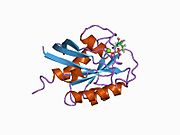











![1iaq: C-H-RAS P21 PROTEIN MUTANT WITH THR 35 REPLACED BY SER (T35S) COMPLEXED WITH GUANOSINE-5'-[B,G-IMIDO] TRIPHOSPHATE](http://upload.wikimedia.org/wikipedia/commons/thumb/4/45/PDB_1iaq_EBI.jpg/180px-PDB_1iaq_EBI.jpg)

![1jah: H-RAS P21 PROTEIN MUTANT G12P, COMPLEXED WITH GUANOSINE-5'-[BETA,GAMMA-METHYLENE] TRIPHOSPHATE AND MAGNESIUM](http://upload.wikimedia.org/wikipedia/commons/thumb/6/62/PDB_1jah_EBI.jpg/180px-PDB_1jah_EBI.jpg)
![1jai: H-RAS P21 PROTEIN MUTANT G12P, COMPLEXED WITH GUANOSINE-5'-[BETA,GAMMA-METHYLENE] TRIPHOSPHATE AND MANGANESE](http://upload.wikimedia.org/wikipedia/commons/thumb/2/2a/PDB_1jai_EBI.jpg/180px-PDB_1jai_EBI.jpg)




